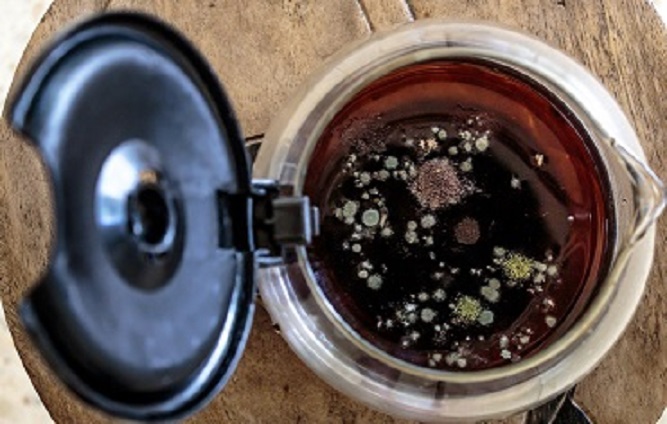Is There Mold in Your Coffee?
To most people, the idea of guzzling down a dark-colored beverage, only to see an insect or piece of nondescript grime at the bottom of the cup, is pretty horrifying. But is this notion better or worse than the idea of drinking a dark-colored beverage overrun with gunk that you can’t see?

Here’s the bad news: that cup of coffee you drank this morning (or 10 minutes ago) may have contained mold spores. Despite coffee’s bitter taste and relative acidity, spores can—and sometimes do—settle and take root on the raw beans, either during the harvesting, fermentation, and drying processes or during transport and storage.
And when those beans are ground up and used to make coffee beverages, the spores that survive the heat and pressure can wind up inside your body.
Sugar? Creamer? Mold?
As always, when dealing with fungi, it’s not necessarily the mold itself that’s a problem. Instead, the danger comes from the mycotoxins that the mold spores produce. Mycotoxins can have a variety of nasty effects on the human body when they’re inhaled or consumed. And certain types of mycotoxins have been known to lurk in coffee beans:
- Aflatoxin B1 – Linked to an increase risk of liver cancer.
- Fumonisin B1 – Linked to neurodegeneration (e.g., brain damage).
- Macrocyclic Trichothecenes – Linked to neurodegeneration and olfactory issues.
- Ochratochin A – Linked to dopamine depletion, which can in turn lead to depression symptoms and chronic fatigue.
It’s worth mentioning that coffee is still considered, by most doctors and medical professionals, to be perfectly safe for adults to drink on a daily basis. And if your liver is healthy and functioning properly, it shouldn’t have a problem removing trace amounts of mycotoxins from your system.
However, if a person consumes large amounts of mycotoxins—e.g., via frequent consumption of heavily contaminated coffee—then they can start to experience serious health problems.
What To Do?
Here are some suggestions for keeping mold spores out of your coffee—and, more importantly, out of your body:
Give up coffee completely. Okay, we’ll readily admit that this option isn’t feasible for everyone. And even if it was, the majority of people who drink coffee on a regular basis probably wouldn’t want to stop, anyway, for various reasons.
With that said, though, if you’re totally ambivalent to coffee (or genuinely don’t like the stuff), it’s definitely not the only option for jump-starting your morning or helping you power through mid-afternoon “sleepies.” These days, there’s a wide variety of teas and beverage blends on the market, several of which boast energy-boosting properties despite being totally caffeine free. Give some of these coffee alternatives a shot, and you may be surprised by how much you like them!
Only drink coffee made from beans grown at a high altitude. High altitudes tend to create drier climates, and drier climates are considerably less hospitable to mold than areas with large amounts of precipitation (or humidity).
Thus, coffee grown in these places is less likely to become infested with mold spores during the fermentation and wrapping processes. When buying packaged coffee, look for the words “High Altitude” somewhere on the label.
Store ground or whole-bean coffee properly. Dry coffee should be kept in an opaque, air-tight container where it won’t be exposed to moisture, heat, and/or light. These measures will help prevent the coffee from growing moldy or stale.
Clean your coffee-making equipment on a regular basis. Coffee machines compatible with single-use pods have gained some flack in recent years, not only because those little disposable pods can be environmentally unfriendly, but also because the machines are trickier to deep clean than traditional, pot-style brewers—and most people have trouble bringing themselves to clean those machines as often as they should!
Regardless of what kind of equipment you use to make your coffee, be sure to clean the unit thoroughly at least once a month. Doing so will keep mold (and other gunk) at bay, and it’ll help your maker produce better-tasting coffee, too. Directions for cleaning your specific machine can easily be found online.
If your coffee smells bad, tastes funny, or has developed an unusual texture, don’t drink it. The act of dumping a full batch of coffee down the drain can be pretty depressing for some people, especially if it means foregoing your morning “cup of joe” entirely. But like with nearly all foods, irregular tastes or smells can be a sign that mold has compromised the stuff.
So play it safe and discard the coffee rather than trying to choke it down. And no, you can’t just scrape off or scoop out “the moldy part” and keep the rest of the coffee! The mold that you can see is only the tip of the iceberg; the spores you can’t see might still make you sick if you ingest them.
Let’s be honest: coffee consumption is a mainstay of American culture, so much so that folks probably won’t stop drinking it any time soon. Unfortunately, this means that many coffee lovers will inadvertently continue to gulp down mold spores, too. But by arming yourself with knowledge and practicing a few different mold-busting techniques, you can help minimize your risk of contamination. You’ll rest easy knowing that the “earthy” taste of your coffee comes from the bean blend and roasting technique—not mycotoxins.
Have a Question?
Send us your comments and questions and our team of mold experts will answer your questions!
"*" indicates required fields
